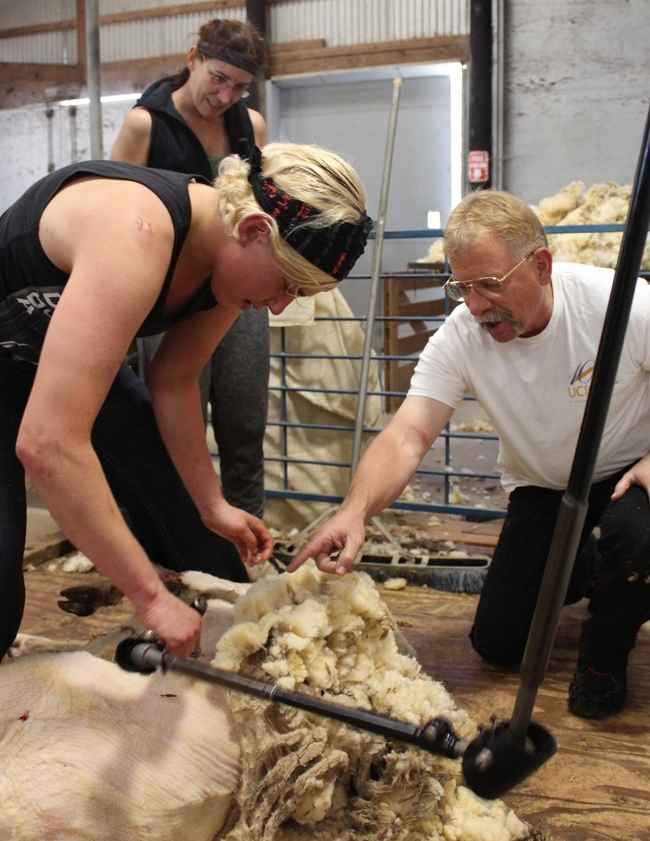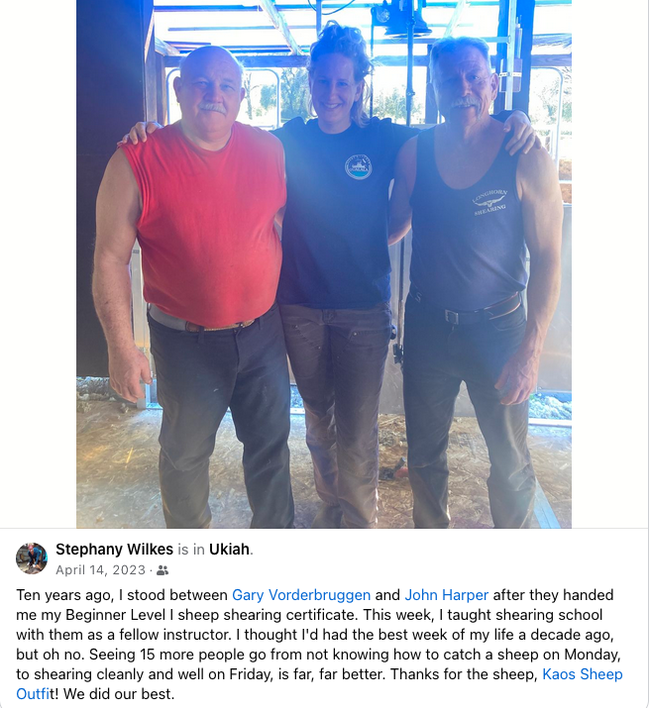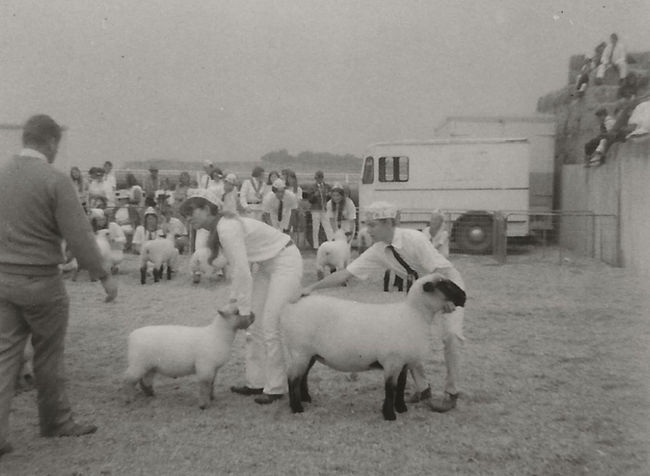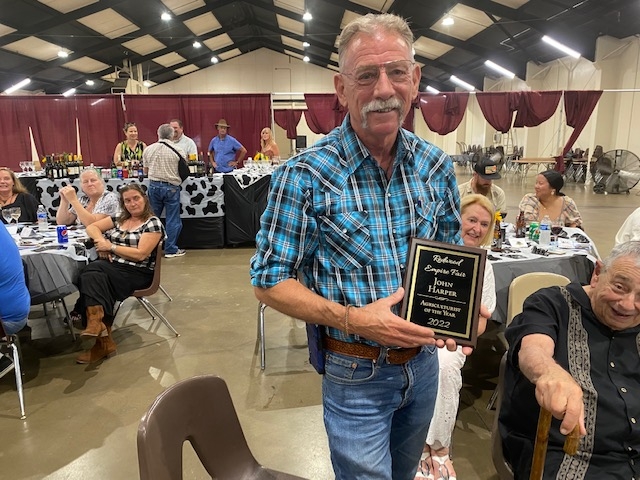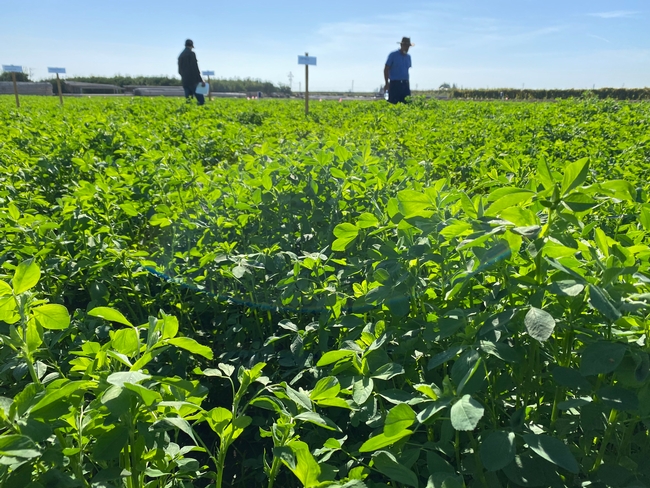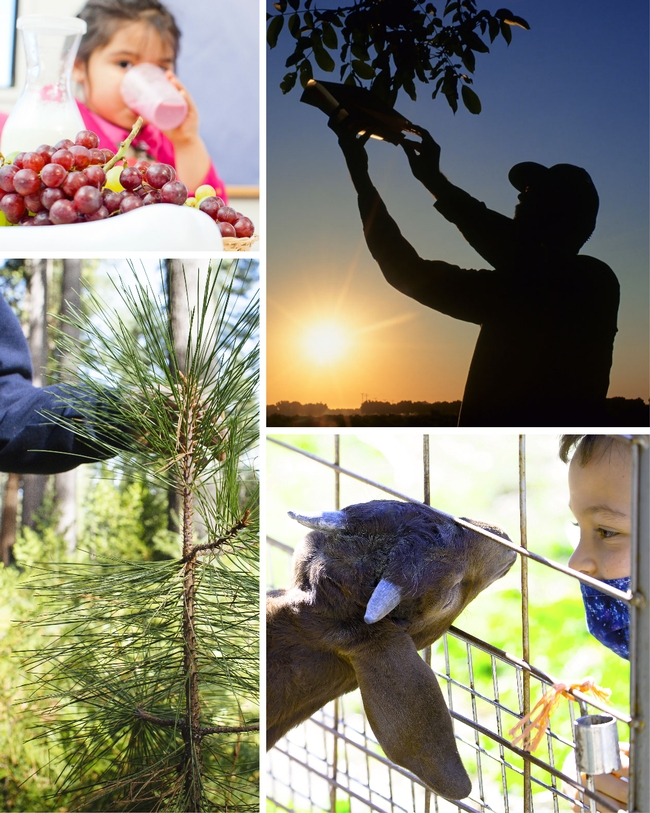- Author: Pamela S Kan-Rice
UCCE livestock advisor John Harper retires after 32 years
"If you know how to shear, you'll never be poor," Stephany Wilkes remembers John Harper, University of California Cooperative Extension livestock and natural resources advisor for Mendocino and Lake counties, telling her sheep shearing class in 2013.
“He was speaking to everyone, of course, but he really spoke to me: being poor (again) is one of my greatest fears and I've avoided it at all costs,” Wilkes said. Harper's words and a certificate from the course gave her the confidence to leave Silicon Valley for greener pastures.
“Eleven years later, with a successful business and published book about shearing to boot, I can confirm John does not lie to his students,” says the former software developer. “More than that, he is encouraging, calm, respectful, experienced, honest, funny and an excellent storyteller. If not for John, I would not have the life I live today.”
Today, Wilkes is a sheep shearer, knitter and author of “Raw Material: Working Wool In the West.”
Harper officially retired July 1, 2023, after 32 years in his UC Cooperative Extension advisor role, but returned to serve as interim director of UCCE for Mendocino and Lake counties until Matthew Barnes was hired on May 1.
For years, UCCE has offered the only five-day sheep shearing school in California, training 15 to 28 students annually, and Harper has been the force behind it.
“Most of the shearers now in the shearing business in California were trained by me and my fellow instructors,” said Harper, the state's Ed Sheeran of sheep shearing.
He first offered the sheep shearing school in 1993 at the Paul and Kathy Lewis ranch in Upper Lake, with subsequent schools at the Stanley Johnson ranch in Booneville. In the early days, Harper brought in instructors from New Zealand, before he and Mike McWilliams, a former member of the USA Sheep Shearing Team, began teaching. Later Harper moved the school to UC Hopland Research and Extension Center, where he has hosted the school for the past 27 years.
With grant funds from the National Sheep Industry Improvement Association, Harper bought shearing equipment and made seven portable shearing pens to offer shearing school at a private ranch in Clear Lake Oaks this year.
“This program is nationally and internationally known and there is a waiting list of over 1,000 people who want to take it,” Harper said.
Harper's baa-ackground in 4-H
Growing up on his family's farm in Yucaipa, just east of San Bernardino, Harper's electrical engineer father gave him a choice between caring for the horses' hooves and shearing sheep. “I chose shearing since I wasn't very big and didn't like horses leaning on me,” he said.
From age 9 to 19, he was active in the California 4-H Youth Development Program, achieving the Gold Star rank. “I was in 4-H with sheep, horses, veterinary medicine, tractor, electrical, welding and woodworking projects,” said Harper, who won the outstanding junior leader award. “I was a junior leader in sheep and won the state award for my sheep project. I showed registered Hampshire sheep, and my flock grew to 50 ewes before I was done.”
“Shearing sheep helped me pay for college,” said Harper, who earned a master's degree in range management at the University of Arizona and a bachelor's degree in animal science and agricultural economics at UC Davis.
After college, Harper worked as an assistant manager on the PolyPay breed development at Nicolas Sheep Farms in Sonoma before starting a career in Cooperative Extension in Arizona.
When Harper joined UC Agriculture and Natural Resources in 1991, the internet was in its infancy, but he recognized its potential for sharing information. He learned how to write code and created the university's first websites for livestock and natural resources. He also was an early adopter of blogging, Facebook, LinkedIn and Twitter to extend information, which earned him a silver award in 2011 from the Association of Natural Resources Extension Professionals.
Beyond shearing, Harper pioneered cutting-edge research
Although sheep are more photogenic on social media, Harper has been flooded with awards and accolades for his water quality research.
Informed by research from Harper, Lake County rancher Russ Rustici created the first rangeland water-quality ranch plan in the state. Rustici was so pleased that he donated research funding for the entire UC Rangeland Watershed Program team and later established two endowed chairs at UC Davis and one at UC Berkeley. The Rustici Endowment now provides research and education grants for rangeland and cattle efforts.
In 1995, Harper and his UCCE colleagues began teaching the Rangeland Water Quality Planning Short Course to help land managers develop water-quality management plans for their ranches to prevent water pollution. By 2015, they had taught more than 80 of these short courses, reaching more than 1,000 ranchers in 35 counties, representing over 2 million acres statewide. In one follow-up survey, 68% of the participants said they had implemented practices on their ranches to protect or improve water quality.
In 2012, the Western Extension Directors Association presented Harper with its Award of Excellence for the Rangeland Watershed Program.
Eating between the vines
For one livestock research project, he and UCCE colleagues trained sheep to graze the grass in vineyards and not eat the grapevines. “The results went viral internationally and really brought targeted grazing to the forefront,” Harper said. “It also raised sheep number by 2% in our two counties.”
In addition to advising ranchers and teaching sheep shearing, Harper has served in several leadership positions, rotating in every few years as UCCE director in Mendocino and Lake counties. From 2014 to 2017, he led UC ANR's Sustainable Natural Ecosystems Strategic Initiative, advocating for the hiring of experts in climate change, economics, small ruminants, forestry and fire.
“I'm especially proud that we were able to recruit a small ruminant extension veterinary specialist – a position that was unfilled for over seven years, despite California being the second-largest sheep-producing state in the nation,” Harper said.
The certified rangeland manager and rangeland professional has long been a member of the Society for Range Management and the American Society for Animal Science. In 2008, he served as president of the California-Pacific Section of the Society for Range Management. Currently he is the secretary/treasurer for the Mendocino/Lake Wool Growers Association and is ad hoc director of the Mendocino/Lake County Cattlemen's Association.
In 2015, the Society for Range Management gave him the Outstanding Achievement Award-Stewardship. In 2017, the California Wool Growers Association bestowed on him its Golden Fleece Award for Lifetime Achievement. In 2019, Harper was named Range Manager of the Year by the California-Pacific Section of the Society for Range Management for his contributions to the profession. In 2022, the 12th District Agricultural Association Redwood Empire Fair honored him with their Mendocino County Agriculturalist of the Year Award.
Harper also received UC Agriculture and Natural Resources' prestigious emeritus status. In retirement, he plans to play his banjo and continue offering the sheep shearing school with GaryVorderbuggen, who has been teaching with him for 18 years. Randy Helms, a former member of the USA Sheep Shearing Team, and Harper's former students Matt Gilbert, Lora Kinkade and Wilkes are among those who have re-ewe-nited with him as sheep shearing instructors.
“John taught the UCCE sheep shearing schools I attended in 2013-2015, and I was deeply honored to teach beside him in 2023 and 2024. It is one of the highlights of my life,” said Wilkes, now better known for working with wool than developing software.
“Like so many past students, I am forever in his debt,” she added. “We've got to keep this shearing school you started going, John. It is a gift. Thank you.”
- Author: Saoimanu Sope
In California, natural and working lands make up 95 million acres of the state and play a vital role in building resilience to the impacts of climate change. University of California Agriculture and Natural Resources was awarded $1.7 million for the California Next Generation and Equitable Climate Action Plan, as part of the state's Natural and Working Lands Climate Smart Strategy and California's 30x30 Initiative, an effort to conserve 30% of the state's lands and coastal waters by 2030.
Natural and working lands include both unmanaged and managed areas actively used for agriculture, forestry or production purposes.
Chandra Richards, UC Cooperative Extension agricultural land acquisitions academic coordinator for Southern California, and Cristina Murillo-Barrick, UCCE's Black, Indigenous and People of Color community development advisor for the Bay Area, are leading the California Next Generation and Equitable Climate Action Plan project.
To build capacity and technical assistance for climate-smart action planning, Richards and Murillo-Barrick will use the Climate Smart Land Management Program funding, awarded through the California Department of Conservation, to focus on two of the most pressing climate action issues: equitable land access and land management diversification.
According to the 2022 U.S. Department of Agriculture census, demographic data indicates that California agricultural land ownership and production is concentrated within an aging and mostly White demographic. However, research suggests diverse management practices promote healthy landscapes. This has been shown to benefit the environment, human health and climate resilience in multiple ways.
For this reason, this project centers on “historically underrepresented communities,” a term that includes California Native American Tribes, communities of color, landless farmers, immigrant and non-English speaking communities and other agency-designated minority groups (racial, ethnic and non-male groups, socially disadvantaged farmers and ranchers, and California designated severely disadvantaged communities).
Focusing on Southern California, UC Cooperative Extension scientists will identify barriers to land access, management and opportunities to increase land manager diversity. They also will engage historically underrepresented communities in coalition building, capacity assessment and climate action planning.
Within the last few decades, Californians have faced increased ecosystem stressors and decreasing diversity of natural systems. This pattern continues to damage already-vulnerable communities (disproportionately historically underrepresented communities), while also worsening and intensifying climate impacts, including drought, wildfire, flooding and disease. Overcoming these kinds of systemic and structural challenges will require the next generation of land managers to reflect California equitably, while preparing them to take on climate resilience. The project will determine clear solutions and plans that enable long-term, strategic land use and protection.
To do this work, UCCE is collaborating with the Community Alliance with Family Farms (CAFF), California Association of Resource Conservation Districts (CARCD) and the California Bountiful Foundation, all of whom serve as subgrantees and will deepen connections with communities.
Organizations like CARCD have long served as “boots on the ground” personnel and have close relationships with landowners and land managers. “RCDs have been hearing the land equity need for a long time and are actively collaborating with different partners to tackle this pressing issue,” said Qi Zhou, program manager of Justice, Equity, Diversity and Inclusion at CARCD and member of the Strategic Growth Council Land Equity Task Force.
“California RCDs are excited about this project because it will allow major California agriculture and conservation partners to collaboratively develop plans and implement projects centering on equity land access and land management diversification,” Zhou added.
Project lead Richards said $270,000 of the grant will be reserved for new partnerships with organizations in Southern California that have experience with, and strong ties to, historically underserved communities.
UC ANR is collaborating with the California Department of Food and Agriculture as well as California Climate and Agriculture Network (CalCAN), and World Be Well, a Southern California nonprofit.
Tawny Mata, CDFA's director of the Office of Environmental Farming and Innovation, described technical assistance providers as being grounded in their local agricultural communities and recognized their importance to partners in the success of CDFA's incentive programs.
“When we do succeed in reaching historically underserved farmers and ranchers with our grant programs, it is often with the thoughtful support and planning of a technical assistance provider,” Mata said. “I look forward to this project helping us refine our own technical assistance funding programs and bringing technical assistance providers together to network and share best practices for improving land access and promoting climate-smart agriculture.”
“The successes of this project will elevate the voices of historically underrepresented communities, strengthening efforts in these communities to support climate action,” said Richards. Additionally, the project will increase sharing of regional reports, needs assessments and community plans surrounding climate-smart management practices. Finally, it will boost technical assistance for these groups specifically.
To learn more about the Climate Smart Land Management Program and this year's awardees, visit:
- Author: Pamela Kan-Rice
- Author: Mike Hsu
- Author: Saoimanu Sope
The most recent group of scientists and educators hired by University of California Agriculture and Natural Resources includes several firsts, including a UC Cooperative Extension specialist in water equity at UCLA and a UC Cooperative Extension Black, Indigenous and People of Color (BIPOC) community development advisor for the Bay Area.
To better serve Spanish-speaking Californians, UC ANR also added a communication specialist to its News and Information Outreach in Spanish unit.
Officially established in 1914, UC Cooperative Extension's researchers work directly with community members to apply research-based information to improve the lives and livelihoods of Californians. Increased funding from Gov. Gavin Newsom and the state Legislature has enabled UC ANR to expand the number of experts working in communities across the entire breadth of the state, from Siskiyou to San Diego counties.
The newly hired UC Cooperative Extension specialists and advisors bring expertise in nutrition, health impacts of climate change, youth development, dairy science, economics, weed management and pest management.
To see a list of UC Cooperative Extension advisors who have joined in the past few months, visit https://ucanr.edu/About/DirectorySearch/Recent_Hires. The most recently hired scientists are introduced below.
De Guzman named first UCCE specialist at UCLA 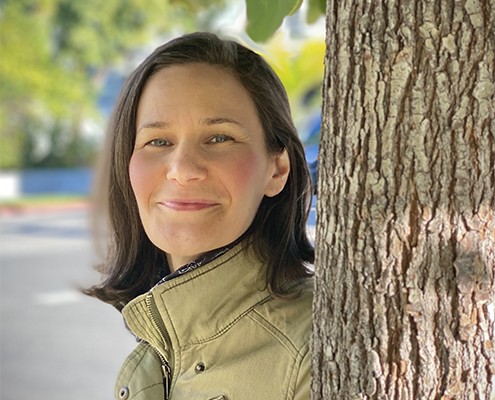
Edith de Guzman joined UC ANR Sept. 1 as a UC Cooperative Extension water equity and adaptation policy specialist. She is the first UCCE specialist to be based at UCLA.
Her work investigates best practices for the sustainable transformation of the Los Angeles region and beyond, and has included research, demonstration projects, public policy and planning in the areas of water management, climate adaptation, heat mitigation and urban forestry. She tackles these topics through the lenses of urban planning, public health, behavioral sciences, biophysical sciences and public policy.
She co-founded and directs the Los Angeles Urban Cooling Collaborative, a multisectoral partnership working to alleviate the public health risks of extreme heat. Their research has found that one in four lives currently lost to extreme heat could be saved if L.A.'s land cover had more trees and its built surfaces were more reflective, particularly where low-income communities and communities of color live and work.
From 2014 to 2020, de Guzman served as director of research at the Los Angeles-based organization TreePeople. Her projects at the nonprofit included the City of Los Angeles Stormwater Capture Master Plan; facilitating the creation of a Greening Plan with the Inglewood and Lennox communities; bringing to fruition multiple urban water-management demonstration projects; and leading an extensive study tour of Australia's response to its historic Millennium Drought and gleaning lessons for California. She also produced the first interactive, high-resolution public map and spatial analysis of Los Angeles County's urban forest.
Having completed all of her studies at UCLA, de Guzman holds a Ph.D. in environment and sustainability, a master's degree in urban planning and a bachelor's degree in history and art history.
Learn more about her research advancing climate resilience and access to clean water and sustainable resources in a Q&A at https://innovation.luskin.ucla.edu/2023/07/31/welcome-to-our-new-water-equity-and-adaptation-policy-expert-edith-de-guzman.
De Guzman is based at the UCLA Luskin Center for Innovation in Los Angeles and can be reached at eb3@ucla.edu and @edithbdeguzman on X, formerly known as Twitter.
Murillo-Barrick named BIPOC advisor for Bay Area 
Cristina Murillo-Barrick transitioned into a new UCCE position on June 1 as the Black, Indigenous and People of Color (BIPOC) community development advisor serving Alameda, Contra Costa, San Francisco and San Mateo counties.
Murillo-Barrick, who had worked as UCCE academic coordinator focused on planning grants for Fresno, Merced, Madera and Tulare counties since 2021, described her new role as “more holistic,” prioritizing historically marginalized communities. Murillo-Barrick will be identifying opportunities to leverage the strengths of BIPOC communities.
In addition to conducting a needs assessment, Murillo-Barrick is planning to form a language access group at ANR – something she is very passionate about. This group will focus on identifying language barriers and best practices by engaging programs like CalFresh Healthy Living, UC and the Expanded Food and Nutrition Education Program that have expertise conducting multilingual programs throughout California. For example, they may recommend increasing accessibility using infographics and/or video, both of which can be translated into different languages and/or dialects.
The realm of diversity, equity and inclusion is not new to Murillo-Barrick, who has worked in outdoor education spaces, serving historically underserved communities of color. “I worked in DEI before it was considered ‘cool,'” she said.
“I have a lot of influence over program development in this role,” said Murillo-Barrick, who is fluent in Spanish. “So, my goal as an advisor is really focused on the community engagement part,” she added.
Murillo-Barrick earned a master's degree in geography and community development and a bachelor's degree in Spanish and international relations at UC Davis. During graduate school, she studied conservation issues in Nicaragua, as well as in her homeland, Costa Rica.
Murillo-Barrick is based out of the UCCE office in Hayward and can be reached at cmurillo@ucanr.edu.
Cervantes joins UC ANR as broadcast communication specialist 
Diana Cervantes joined UC ANR on Sept. 5 as the new broadcast communication specialist for News and Information Outreach in Spanish, or NOS.
Cervantes brings over 25 years of experience as a journalist serving the Spanish-speaking community in Southern California to help fulfill the NOS mission of disseminating information to California's Spanish-speaking community.
Before joining NOS, Cervantes was an editor for El Latino, the most widely circulated Spanish-language newspaper in San Diego County. She participated in the creation of the El Latino website and spearheaded the newspaper's digital platform migration.
Her professional journey includes working as a reporter for La Opinión, the largest Spanish-language daily newspaper in the nation, as well as a reporter for La Prensa/The Press Enterprise in Riverside.
She is bicultural and bilingual, qualities that uniquely equip her to understand the needs and nuances of the immigrant community in this country.
Cervantes holds a bachelor's degree in communication sciences with a minor in written journalism from Universidad Autónoma de Baja California.
"I am very happy for the opportunity to participate in the valuable work that UC ANR does to bring knowledge to the Hispanic community," Cervantes said.
Cervantes is based at the UC ANR office in Riverside and can be reached at diacervantes@ucanr.edu.
Hill named weed science and agronomy advisor 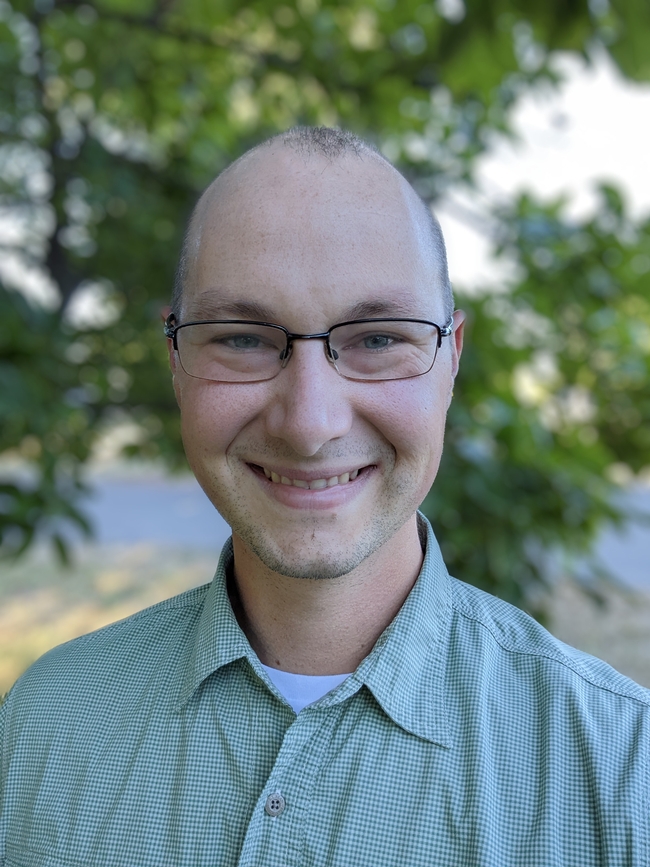
Ryan Hill joined UCCE on Aug. 14 as a weed science and agronomy advisor in Tehama, Shasta and Glenn counties.
In his new role, Hill will be exploring safe and effective weed-management options for a range of cropping systems in the northern Sacramento Valley. He also will be advising on production of agronomic crops to support growers who are looking for ways to diversify their farming operations.
When the UC Master Gardener Program gets established in Tehama County, Hill will provide academic oversight for the local program.
“I have been very fortunate to have a wide background of experience in agricultural research and I intend to draw on that as much as I can as a UCCE advisor,” Hill said. “I also intend to draw on the diverse array of resources and expertise that UC ANR has to offer to support my research and extension programs, as well as the Master Gardener program. I am looking forward to making consistent progress toward more sustainable food systems as a member of the UC ANR team.”
Before joining UC ANR, Hill worked for the Oregon State University Extension Service, the California processing tomato industry, and the Joint Genome Institute. At OSU, he managed research operations and field plantings at the research farm for 3.5 years, while learning weed science. He worked on weed control and herbicide safety projects in hazelnuts, hops, caneberries, cranberries, blueberries, ornamental trees and shrubs, apples, cherries, pears, wine grapes and Christmas trees.
Hill earned a master's degree in plant breeding and genetics from Oregon State University, where he studied the genetics of self-incompatibility in hazelnuts. He earned a bachelor's degree in biology from George Fox University in Newberg, Oregon.
“I was born and raised in Stanislaus County,” Hill said, “and I am happy to be back in the Central Valley after spending the last six years in Oregon.”
Hill is based in Red Bluff and can be reached at rjahill@ucanr.edu.
Branco Lopes joins UCCE as dairy advisor for Tulare, Kern counties 
Rúbia Branco Lopes joined UC Cooperative Extension on Aug. 1 as a dairy farm advisor for Tulare and Kern counties.
She is looking forward to working with dairy producers, consultants and allied industry throughout Tulare and Kern counties. Branco Lopes aims to develop a research and outreach program that will contribute to the competitiveness and profitability of California dairies.
Raised on a beef ranch in Brazil, Branco Lopes nurtured an interest in agriculture from an early age.
She came to the U.S. to work as a visiting scholar at the UC Veterinary Medicine Teaching and Research Center in Tulare. At VMTRC, among other projects, she studied the feeding management of close-up rations in California dairies.
Recently, Branco Lopes finished her Ph.D. in animal biology from UC Davis. Her dissertation investigated the effect of probiotics on growth of dairy calves and assessed the safety of commercial cattle probiotic products. During her academic career, she conducted research mainly on ruminant nutrition and antimicrobial stewardship.
She holds a bachelor's degree in agronomy and a master's in animal science from Federal University of Rio Grande do Sul, Brazil.
Branco Lopes is based out of the UC Cooperative Extension office in Tulare and can be reached at rbrancolopes@ucanr.edu.
Vega joins UCCE in San Diego and Orange counties 
Liliana Vega is the new UC Cooperative Extension 4-H youth development advisor serving San Diego and Orange counties as of Aug. 1.
Her research and outreach focus on positive youth development through a JEDI (Justice, Equity, Diversity, and Inclusion) lens, STEAM (Science, Technology, Engineering, Arts and Math), youth leadership, outdoor education, and college and career readiness/workforce development programs focused on reaching BIPOC (Black, Indigenous and People of Color) youth and families.
Vega holds a bachelor's degree in multi-ethnic and Mexican American studies from Boise State University and a master's degree in adult/organizational learning and leadership from the University of Idaho.
With over 15 years of experience as a 4-H professional – previously serving San Luis Obispo, Santa Barbara and Ventura counties for the last five years and in Idaho's Ada and Canyon counties before that – Vega feels prepared for her new role as an advisor in San Diego and Orange County.
In 2021, Vega was part of the team that won a Diversity & Inclusion Award from the National Association of Extension 4-H Youth Development Professionals for increasing the number of Latino youths participating in the California 4-H program by more than 250% over three years.
“I'm excited to forge new partnerships in San Diego and Orange counties and collaboratively work to provide access to experiential learning, increase youth-adult partnerships, and help youth gain the support they need to grow and thrive as individuals,” she said.
Vega has extensive experience in forming community partnerships to deliver quality youth development programs, with a focus on increasing access for minority, low-income and underserved audiences. Her expertise is in culturally adapting programs for the Latinx community.
Currently, Vega serves on the National 4-H LGBTQ+ and Immigrant/Refugee Youth and Community Champion Groups. She also chairs the 4-H Statewide JEDI Advisory Committee, California 4-H True Leaders in Equity Youth Taskforce, and UC Agriculture and Natural Resources' Career/College Readiness and Workforce Development Workgroup.
Vega is based at the UCCE office in San Diego and can be reached at live@ucanr.edu.
Ramirez Bonilla named pesticide-safety education program coordinator 
Jasmin Ramirez Bonilla joined the UC Statewide Integrated Pest Management Program on July 10 as a pesticide-safety education program coordinator. She is working on projects promoting pesticide safety.
Prior to joining UC ANR, she worked for the CDFA Plant Pest Diagnostics Branch as a lab technician for the molecular lab, analyzing and processing crop samples for nematode identification.
Ramirez Bonilla earned a master's degree in entomology from UC Davis and bachelor's degree in Earth systems science from UC Merced. At UC Davis, she worked under the supervision of Ian Grettenberger, UCCE specialist, on IPM in forages and vegetable crops. For her thesis, Ramirez Bonilla researched the efficacy of an experimental aggregation pheromone for the management of cucumber beetles, key pests of fresh market melons in California.
Ramirez Bonilla is based at the ANR building in Davis and can be reached at jramirezbonilla@ucanr.edu.
Van Cleave-Hunt named UCCE nutrition, health and food security advisor

Before beginning her current position, Van Cleave-Hunt served for four years as a community education specialist for the CalFresh Healthy Living, UC program before becoming the program supervisor serving the same counties.
“Luckily, I already have my finger on the pulse of the community in these five counties just through my experience with CalFresh. I've been able to build rapport and connections with a lot of community partners and stakeholders,” said Van Cleave-Hunt.
As an advisor, Van Cleave-Hunt will focus on nutrition, education and healthy living efforts for people who are at a disadvantage, for example, those living in food deserts or experiencing food insecurity, a term used to describe the societal and environmental barriers to access and manage food.
“Food security is about environment and access, but also skills related to food,” Van Cleave-Hunt said. “For instance, budgeting, even things like gardening, cooking and knowing how to prepare food so that you don't always have to buy ready-made food, or how to store things properly so that they last as long as possible.”
According to Van Cleave-Hunt, food security includes skills that will help you get the most out of the food that you have.
Currently, Van Cleave-Hunt is compiling secondary data to conduct a needs assessment. In addition to engaging stakeholders such as resident service coordinators at low-income housing units or community organizations, she is also working with the State Council on Developmental Disabilities to develop healthy living trainings and curricula that will benefit communities in her counties.
Van Cleave-Hunt said that her time with UC Cooperative Extension has been a “full-circle journey” since she studied human behavior and health in school. She started her undergraduate career at Santa Rosa Junior College before transferring to California State University, Chico where she earned a bachelor's in nutrition and a master's degree in nutrition education.
Chelsey Slattery, former UCCE area nutrition, family, and consumer sciences advisor for Butte County, recruited Van Cleave-Hunt right out of college to be a UC Cooperative Extension community education specialist. Today, Van Cleave-Hunt holds the position that Slattery once did.
Van Cleave-Hunt can be reached at vvancleavehunt@ucanr.edu and is based in Oroville.
Wayne joins UCCE as food systems advisor 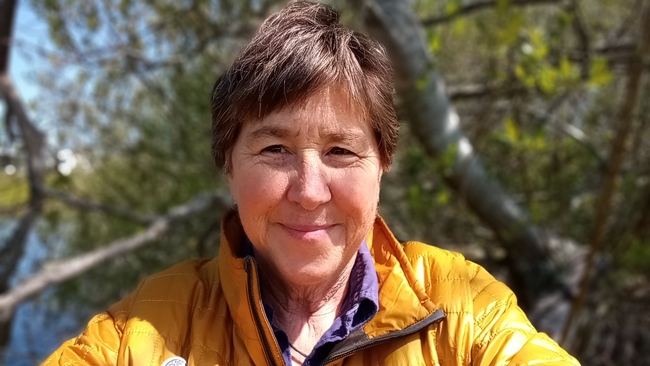
Laurie Wayne joined UC Cooperative Extension on July 5 in Modoc County as a nutrition and food systems advisor for Modoc, Lassen and Siskiyou counties. Wayne will work with community members on healthy lifestyles, nutrition, food access and security, local food production, preservation and availability.
Wayne brings years of high-desert food systems experience to her role: she owned and operated Locavore Farms in Fort Bidwell, helped found the Surprise Valley Saturday Market and Modoc Harvest, and was on the team that started the Modoc Harvest Food Hub. She also has worked supporting healthy communities for Oregon State University Extension in Klamath Falls, and at the High Desert Food and Farm Alliance in Bend, Oregon.
She earned a master's degree in TESOL (to teach English as a second language) from Portland State University and worked in school and community gardens with immigrants and refugees as part of her research project. She earned a bachelor's degree in Italian literature from UC Santa Cruz.
This job feels like the culmination of the farming, studying, supporting farmers and working in food systems she has done in the past 15 years, Wayne said.
“I'm especially interested in working on expanding access to affordable, healthy, local food year-round, including extending and preserving the harvest,” Wayne said. Her goal is to help everyone feel empowered to make healthy food choices, and she's learning what resources producers need to improve processing, transportation and production strategies, and overcome barriers that are unique to the region.
To better understand both the food systems needs and the abundant food assets of northeastern California, she will be meeting with community members; state, local and regional nonprofits; schools and other organizations in the next few months. They will discuss ways to strengthen community food system resilience.
“It's all about healthy community members who can eat good local food without breaking the bank, and producers who can make a living feeding them,” Wayne said.
Based in Alturas, Wayne can be reached at lwayne@ucanr.edu and (530) 233-6400.
Hyland named UCCE environmental health sciences specialist 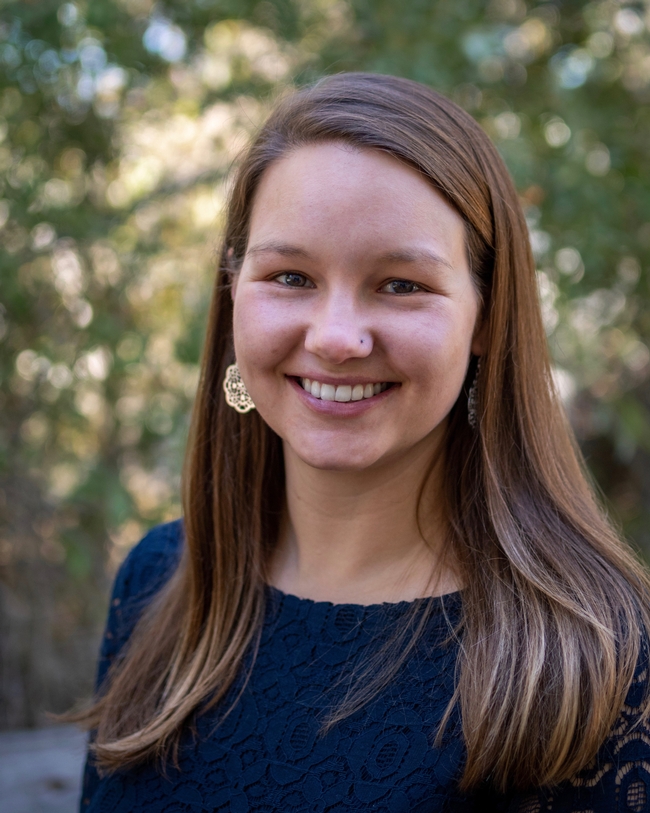
Carly Hyland joined UC ANR in July as a UC assistant Cooperative Extension environmental health sciences specialist and assistant professor in the UC Berkeley School of Public Health.
She recently finished a mixed-methods project at Boise State University examining pesticide exposure and perceptions of the risks of pesticides among Latino men and women farmworkers in Idaho. In California, she is pursuing projects examining interventions to protect farmworkers from pesticides, extreme heat and wildfire smoke in collaboration with community partners.
“There are so many reasons I wanted to come back to Berkeley, and I think one of the biggest motivating factors for me was the collaborative environment focused not just on conducting innovative research, but also translating those findings into solutions to improve community health,” Hyland said. “Farmworkers are increasingly experiencing the health impacts of climate change on a daily basis, and this position will provide me with the resources and collaborations necessary to identify strategies to address these urgent issues.”
Hyland earned her Ph.D. in environmental health sciences and master's degree in global health and the environment, both from UC Berkeley, and bachelor's degree in environmental science from Carthage College in Wisconsin.
Hyland is based at UC Berkeley and can be reached at chyland@berkeley.edu and on X (formerly Twitter) @c_hyland1.
Smith-Helman joins Climate Smart Agriculture Program 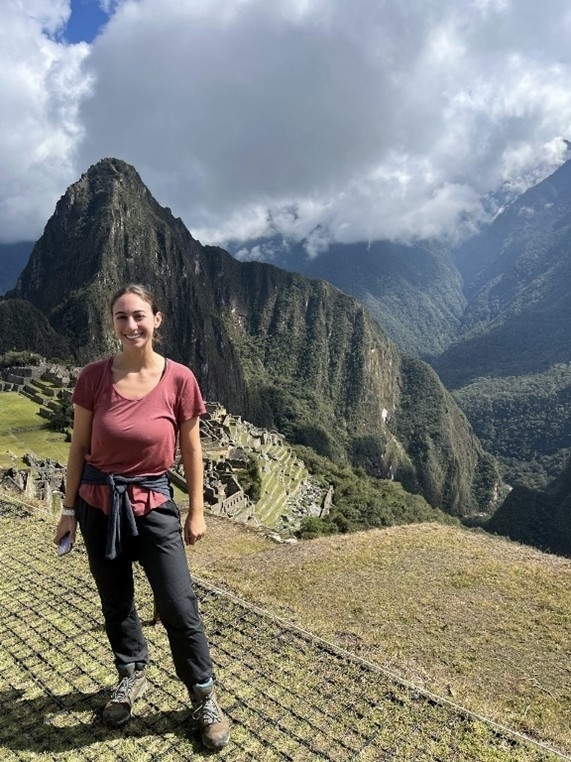
Bailey Smith-Helman joined UCCE Santa Cruz County on July 3 as a community education specialist with the UC ANR Climate Smart Agriculture Program.
Smith-Helman, who relocated from Washington, D.C., is excited to get back in the field and support Santa Cruz County growers with climate-smart agriculture practices and California Department of Food and Agriculture financial incentive programs.
CDFA programs provide financial incentives to eligible farmers and ranchers implementing new practices that maximize water efficiency, build soil health, and improve manure management. She is ready to assist interested growers with grant applications, project planning and implementation.
After graduating from Northwestern University with a bachelor's degree in political science and environmental policy, Smith-Helman moved to Paraguay to serve as an agriculture volunteer with the Peace Corps. In Paraguay, she worked closely with agricultural educators and local producers to develop education plans and lessons to engage high school students in agricultural coursework.
After returning to the U.S., Smith-Helman worked for USDA Supplemental Nutrition Assistance Program, where she gained experience in agriculture policy analysis and program management.
Smith-Helman is based in Watsonville and can be reached at bsmithhelman@ucanr.edu.
Sayre named UCCE agriculture and resource economics specialist 
James “Jay” Sayre joined UC Cooperative Extension and the UC Davis Department of Agriculture and Resource Economics as a CE Specialist on July 1.
His role focuses on the economics of food supply chains across the state of California. Sayre aims to study policies to promote greater competition in food supply chains to benefit smaller-scale producers, understand the role of international trade in agriculture and its effects on Californian consumers, and assess how supply chains can best respond to a changing climate.
Sayre is excited about combining economic theory and modeling approaches with understanding the needs of stakeholders in California to benefit food supply chains within California.
Sayre earned a doctorate in Agricultural and Resource Economics at UC Berkeley. His dissertation research spanned several disciplines, with chapters seeking to understand how agricultural supply chains lead regions to specialize in certain crops, the consequences of phytosanitary and other non-tariff barriers to trade, as well as developing methodology to accurately assess crop yields across large regions using satellite imagery and other sources of publicly available data. He earned a bachelor's degree in economics and mathematics from the University of Minnesota-Twin Cities.
The Colorado native is looking forward to addressing a variety of issues relevant to California stakeholders. An ongoing project looks to develop fine-scale projections of future agricultural productivity for most of the major crops California produces, including crops that have historically not had such measures available, like perennials such as almonds, avocados and other fruits.
He hopes such information will be relevant not only for growers seeking to understand whether their land will be relatively more suitable in the future for different crops, but also agricultural intermediaries and policy makers looking to understand where production of certain crops may shift in the future.
Before joining Cooperative Extension and UC Davis, Sayre worked in Mexico, seeking to better understand the cross-border nature of supply chains that operate in both California and Mexico. He is proficient in Spanish and aims to increase the accessibility of extension to Spanish speakers.
Sayre is based out of the Department of Agriculture and Resource Economics at UC Davis and can be reached at jsayre@ucdavis.edu.
Valliere joins UCCE as weed and restoration ecology specialist 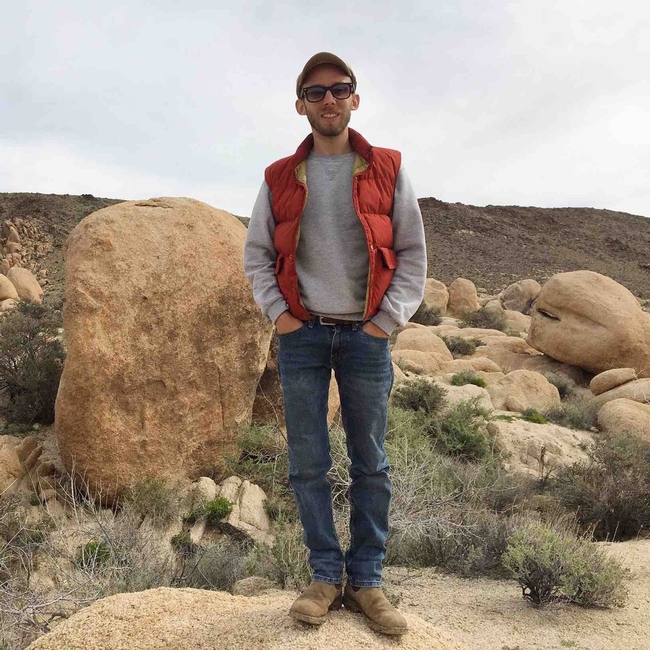
Justin Valliere joined UC ANR on July 1 as an assistant professor of Cooperative Extension in invasive weed and restoration ecology at UC Davis.
Valliere's research aims to evaluate how human-caused environmental change and invasive plant species impact native ecosystems, and how we can reverse this degradation through ecological restoration. The overarching goal of his research and outreach is to develop real-world solutions for land management in the face of global change.
“CE already is such an effective system for supporting agriculture, but it's also an important model for natural resource management and restoration,” Valliere told Trina Kleist, writer for the UC Davis Department of Plant Sciences. “There is a real need for help advising folks throughout the state about managing and restoring natural lands, and I'm excited to help bolster that.”
Prior to joining UC Davis, Valliere was an assistant professor of biology at CSU Dominguez Hills, a research fellow at the University of Western Australia, and a postdoctoral fellow at the La Kretz Center for California Conservation Science at UCLA.
Valliere earned his Ph.D. in plant biology from UC Riverside, and a bachelor's degree in biology from Green Mountain College in Poultney, Vermont.
Valliere is based in the Department of Plant Sciences at UC Davis and can be reached at jmvalliere@ucdavis.edu.
Hill named UCCE specialist in diversity and equity economics 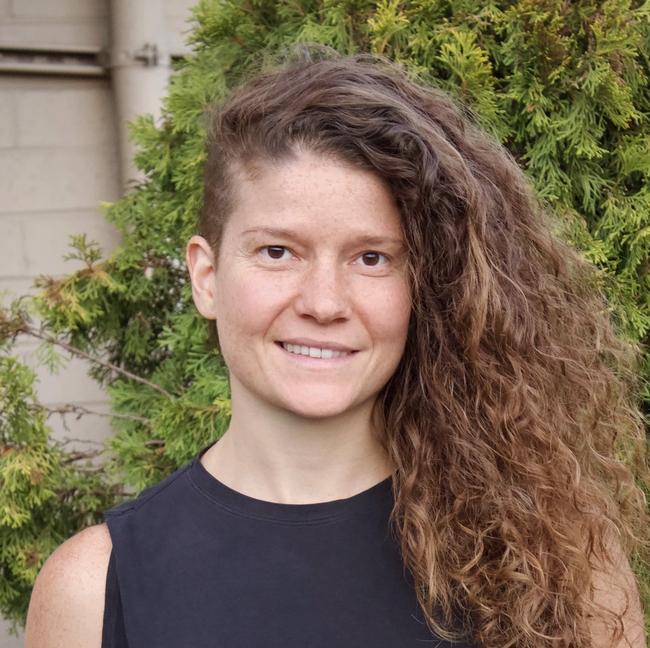
Alexandra “Ali” Estvan Hill joined UC ANR and UC Berkeley's Department of Agricultural and Resources Economics on July 1 as an assistant professor of Cooperative Extension specializing in the economics of diversity and equity.
From 2019 until she joined UC, Hill worked as an assistant professor of agricultural economics at Colorado State University. Her research centers around the U.S. agricultural workforce and seeks to demonstrate how a variety of factors impact worker well-being, quantified in terms of income or health impacts – and to make a business case for employers, in terms of implications for production or profits, to institute policies and practices that promote worker well-being.
Hired farmworkers contribute greatly to the racial, ethnic, cultural and socioeconomic diversity of U.S. agriculture; however, they are frequently not treated equitably and face a multitude of economic, physical, legal and emotional hardships in their personal and professional lives. Hill's research seeks to begin dismantling these inequities by finding avenues through which employers can increase worker well-being while maintaining or increasing profits.
Hill brings extensive experience working with individual agricultural businesses to accomplish these objectives through enhancing firm data collection and analysis to provide an array of effective, efficient and actionable insights.
She is building an extension program centered around advancing diversity, equity, inclusion and belonging in the agri-food system by enhancing the well-being of agricultural employees and other disadvantaged members of rural and urban agricultural communities.
She earned her Ph.D. in agricultural and resource economics from UC Davis and master's degree in agricultural and applied economics and bachelor's degree in agricultural and consumer economics from University of Illinois, Urbana-Champaign.
Hill is based at UC Berkeley and can be reached at alihill@berkeley.edu and on LinkedIn www.linkedin.com/in/alexandra-estvan-hill.
- Author: Pamela Kan-Rice
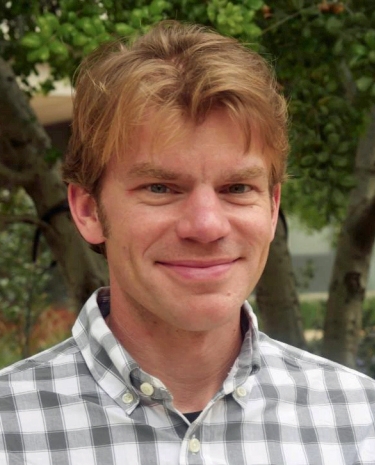
Porse has built an outstanding career in water as a research engineer with the Office of Water Programs at California State University, Sacramento and an assistant adjunct professor with UCLA's Institute of the Environment and Sustainability. His research focuses on urban and water resources management. He specializes in bringing together interdisciplinary teams to investigate complex environmental management questions.
Porse earned a Ph.D. in civil and environmental engineering (water resources) from UC Davis and a master's degree in public policy (science and technology) from George Mason University. His professional experience includes international work and teaching in Mexico, Europe, Japan and East Africa. He has authored over 50 reports and peer-reviewed articles.
“UC ANR is fortunate to have a director with broad professional experience in science and policy at the United Nations, the U.S. government, private sector firms and research laboratories,” said Deanne Meyer, UC ANR interim associate vice president for programs and strategic initiatives. “Erik's recent research has collaborated with scientists and projects addressing priority areas in the California Water Resilience Portfolio, including safe drinking water, efficient urban water use, sustainable groundwater management, water reuse, beneficial uses of stormwater, and environmental finance.”
The CIWR is the California hub of the national network of water research institutes supported by the federal Water Resources Research Act of 1964 and provides and communicates solutions to complex water issues and will serve a critical role to support applied water research that tackles large problems with systems approaches, including groundwater recharge, water rights, irrigation management, water finance, and drinking water access. The CIWR works with scientists throughout California as well as through the national network to bring defensible solutions and alternatives to California's water management community.
“Water is a necessity for life and management of water is essential for California's economy and prosperity,” Meyer said. “Porse's leadership with multidisciplinary research teams, water policy research, and integrated systems modeling will serve the CIWR and ANR for years to come.”
Porse succeeds Doug Parker, who retired in 2022 after 11 years as CIWR director.
- Author: Pamela Kan-Rice
University of California Agriculture and Natural Resources continued hiring county-based scientists at a rapid pace over the summer. With increased funding from Gov. Gavin Newsom and the state Legislature, UC ANR recently hired UC Cooperative Extension advisors who bring expertise in wood products, wildfire, wildlife, food systems, urban and small-scale farms, 4-H youth development, pest management, drought, nutrition and environmental horticulture.
UC Cooperative Extension advisors work directly with community members to apply research-based information to improve the lives and livelihoods of Californians.
To see a list of UC Cooperative Extension advisors who have joined in the past few months, visit https://ucanr.edu/About/DirectorySearch/Recent_Hires. The most recently hired advisors are introduced below.
Chen named woody biomass and wood products advisor 
Cindy Chen joined UC Cooperative Extension Sept. 6 as a woody biomass and wood products advisor for the Central Sierra and Alpine and Mariposa counties.
After receiving her bachelor's in social ecology and master's in demography from UC Irvine, Chen completed her Ph.D. in environmental and forest sciences from the University of Washington, specializing in wood products processing and marketing. Chen has worked and lived in all three West Coast states over the past 20 years and she is familiar with the natural environment in the western U.S.
Her multidisciplinary expertise allows her to work on a wide range of projects covering topics such as population forecasting, environmental assessment, woody biomass transportation logistics, the end-of-life treatment of wood products and mass timber production optimization.
Chen has worked with nonprofit organizations, government agencies, research scientists and local stakeholders to investigate the environmental and economic benefits of wood utilization in the construction and energy industries. Her work in evaluating the environmental impacts of Cross Laminated Timber (CLT) production helped prepare for the opening of North America's largest mass timber manufacturing facility in Washington.
In addition to her work in the U.S., Chen also has collaborated extensively with international partners in research projects that explored the global market potential for wood products and bioenergy.
About this position, Chen says, “As the woody biomass and forest products advisor at UC ANR, my goal is to work with the Central Sierra communities in exploring innovative ways to better utilize California's forest resources and biomass, developing biomass processing programs that are appropriate for the region and contributing to local economic development.”
Chen is based in Tuolumne and can be reached at cxnchen@ucanr.edu.
Low brings fire expertise to communities statewide 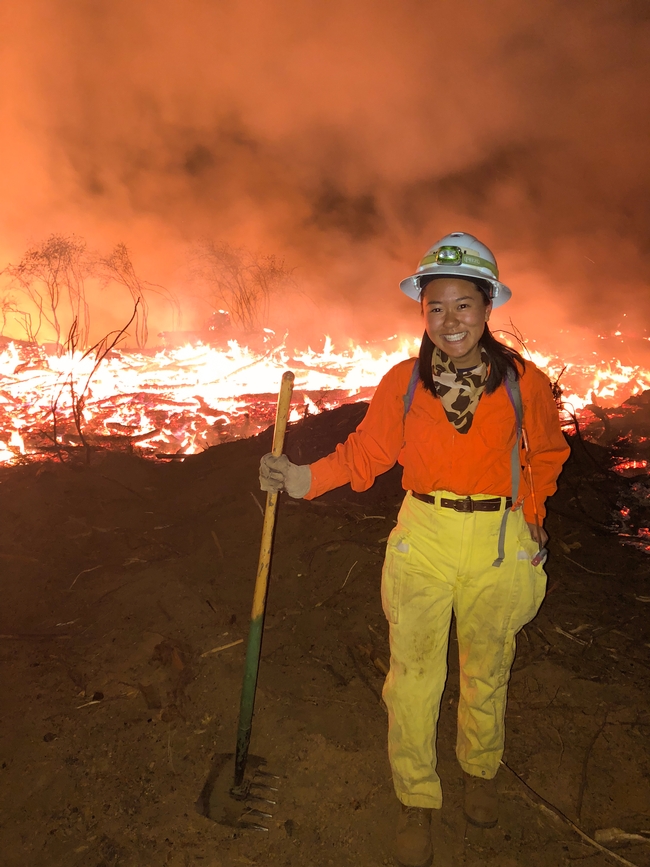
Katie Low, who began as the University of California Cooperative Extension statewide fire coordinator on Sept. 1, will fulfill two important functions for UC ANR's team of fire experts.
First, she will coordinate and partner with UCCE fire advisors throughout California to develop and deliver wildfire-related science and outreach materials for a wide range of communities across the state. Low said encouraging diversity in the network of fire experts and engaged communities will be crucial.
“One of my goals is to help build and maintain a diverse and inclusive community of fire and natural resource professionals,” she said.
Second, based at the UCCE office in Auburn, Low will collaborate with local natural resource professionals and residents in Nevada and Placer counties on projects that bolster community and ecosystem resilience to wildfire and climate change.
“I look forward to working with community groups, land managers and scientists to implement viable fire-resilient management strategies for ecosystems in the region and statewide,” Low said.
Equipped with bachelor's degrees in geography and ecosystems management and forestry, as well as a master's in forestry, all from UC Berkeley, Low brings a wealth of knowledge and a variety of experience.
As a fire and forest ecologist, she studied the impacts of fuels-reduction and forest-restoration treatments on Sierra Nevada mixed-conifer forests. Low also worked as operations coordinator for the California Outdoor Engagement Coalition, and as a forestry aide for the California Department of Forestry and Fire Protection's Forest Biometrics Program.
Low can be reached at (530) 889-7385 and katlow@ucanr.edu; follow her on Twitter @lowseverityfire.
Deak named fire advisor for Mariposa, Fresno and Madera counties 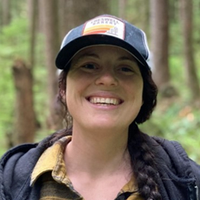
Alison Deak joined UC Cooperative Extension on Aug. 22 as a fire advisor for Mariposa, Fresno and Madera counties. Since she began work, Deak has been focused on conducting a needs assessment and building rapport with community leaders.
Her role as fire advisor will include promoting the use of prescribed fire to help restore fire adapted landscapes. She will also prioritize community education, applied research and partnership building efforts that are based on scientifically informed ways to help communities mitigate, prepare for, and recover from wildfire.
Originally from northeast Ohio where there are no wildfires according to Deak, it was not until she moved to Colorado for college that she learned of their impact.
When the 2012 Waldo Canyon Fire occurred, Deak felt like her playground was burning down so she acted. She began volunteering with the wildfire recovery effort and her career into fire science took off from there.
Deak earned a bachelor's degree in geography and environmental studies from the University of Colorado, Colorado Springs and master's degrees in geography and nonprofit management from the University of Oregon.
Before moving to California and joining UC ANR, Deak worked as a wildland firefighter with the U.S. Forest Service and Bureau of Land Management.
When asked what she is looking forward to most, Deak shared that she is passionate about increasing diversity in the fire science field and, particularly, empowering more women to join. She is eager to help community members prepare for wildfire and mitigate fire risk in a safe and competent manner.
Deak is located at the UC Cooperative Extension office in Mariposa County and can be reached at aldeak@ucanr.edu.
Henry joins UC ANR as food systems advisor for capitol region 
Olivia Henry joined UC ANR on Aug. 15 as regional food systems area advisor for Solano, Yolo, Sacramento, Placer and Nevada counties. Henry will focus on issues related to marketing, resilient supply chains, distribution infrastructure, processing infrastructure, financing models and food waste.
Prior to joining UC ANR, Henry worked in various newsrooms – including CapRadio, the Mendocino Voice, KALW Public Radio, San Francisco Public Press and Mother Jones – in community engagement, membership and communications roles. She also worked with Internews, a media development organization, to conduct information needs assessments in the San Joaquin Valley and Inland Empire regions.
Henry is still involved with community media, and currently serves as the assistant editor of a bimonthly, English and Spanish-language newspaper, “The Ivanhoe Sol,” in rural Tulare County.
She earned her bachelor's degree in journalism from Western Washington University and master's degree in community development from UC Davis. While at Davis, Henry studied models of community- and employee-owned news enterprises, with a focus on how stakeholder ownership can protect journalism as a public good. She also earned a graduate certificate in extension outreach and communication.
Henry said she is excited to be a part of UC ANR, which she has benefitted from as a certified California Naturalist and candidate California Master Beekeeper. She has previously worked at local farms, including a diversified orchard and targeted grazing operation.
Henry is based in Fairfield and can be reached at omhenry@ucanr.edu.
Neas named 4-H advisor for San Mateo, San Francisco counties 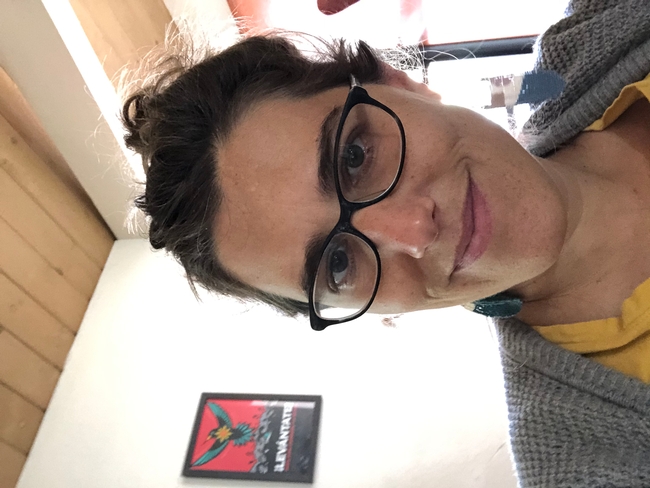
Sally Neas began working as the 4-H youth development program advisor for UC Cooperative Extension in San Mateo and San Francisco counties on Aug. 1.
In her role, Neas incorporates environmental education into youth programs at Elkus Ranch and 4-H community clubs. She is also responsible for conducting research and developing new programs.
Neas has worked in youth development and environmental education for several years. When she first moved to California 12 years ago, she worked for Veggielution Community Farm in San Jose and helped launch their first youth development program.
Since then, she has worked in after-school programming focused on gardening and nutrition in Santa Cruz and has dedicated her time and energy to engaging youth in conversations about climate change.
“I'm interested in building conversations around climate change that focus on culturally relevant and personally meaningful approaches. Not a deficit approach that asks what we're going to give up, but what can we do as a collective,” said Neas.
Neas earned a doctorate in environmental education at UC Davis and a bachelor's in environmental studies from the University of the South in Tennessee.
Neas centered her dissertation on how young people understand and define climate change. Her research relied on oral histories collected from “youth that, historically, are not represented in the climate change space” such as youth of color and queer youth. To capture their stories, Neas initiated a digital storytelling project, drawing on the collaboration between art and science.
“I really felt bothered by not hearing educators adequately address climate change. It felt like a looming elephant in the room, where we either didn't talk about it at all or what we were saying wasn't helpful,” she said.
According to Neas, youth have a moral compass that, unlike in adults, has not been so degraded. Their creativity, compassion and drive inspire Neas to preserve these parts of herself. Moving forward, she is eager to create programs that are inclusive and representative of all youth that she serves.
Neas is based in Half Moon Bay and can be reached at seneas@ucanr.edu.
Norville named fire advisor in Sonoma, Napa and Marin counties 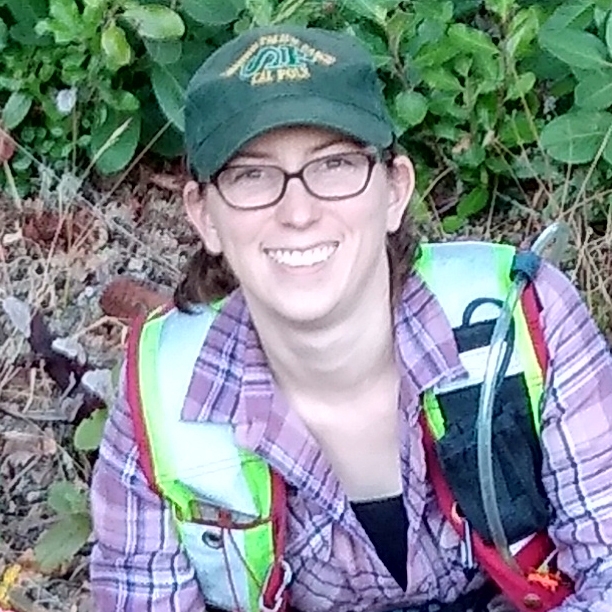
Tori Norville started on Aug. 1 as the new UC Cooperative Extension fire advisor for Sonoma, Napa and Marin counties.
In this capacity, Norville will work with residents and organizations within the wildland-urban interface to encourage and cultivate fire-adapted communities. She aims to provide education and outreach on home hardening, defensible space and the importance of forest and fuel management on the landscape.
While pursuing her bachelor's degree in forestry and natural resources at Cal Poly San Luis Obispo, Norville became interested in “disturbance ecology” – how factors such as disease, insects and fire affect landscapes and environments.
“Many of the forest health problems we are seeing are stemming from a lack of disturbance, which traditionally was fire,” Norville said.
Her understanding of fire and its effects deepened during her master's degree studies in forestry science (also at Cal Poly SLO), as well as through her seven years with CAL FIRE at the Jackson Demonstration State Forest in Mendocino County. She worked as the Registered Professional Forester for its Timber Sales Program, and then the Research and Demonstration Program.
Norville's firsthand experiences from the past few fire seasons have helped shape her goals and approach. She hopes to “work holistically with disturbances” – specifically fire – on the landscape to foster healthy forests and ecosystems that are adaptable and resilient, while also researching the environmental and social aspects of fuel-reduction projects and prescribed fire.
“Hopefully, I can begin to change the perception of fire from something we need to fear, to something we respect,” she said.
Norville, based at the UCCE office in Santa Rosa in Sonoma County, can be reached at trnorville@ucanr.edu.
Atim named UCCE specialist studying crop drought resilience 
Jackie Atim began working as a UC Cooperative Extension specialist affiliated with UC Merced on July 11, based at Kearney Agricultural Research and Extension Center in Parlier.
Atim's work will include applied research focused on abiotic stress, which includes plant stress caused by extreme temperatures, high salinity, floods, drought or nutrient deficiency. In particular, she will be studying the genetic makeup of sorghum, its resistance to drought and the value it contributes to byproducts such as bioenergy.
California, as Atim explained, is an ideal place to study drought resilience given its semi-arid climate and water challenges. She is hopeful that California will establish sorghum as a climate-smart crop for forage and grain to address the challenges facing water-stressed production systems.
Furthermore, Atim will focus on “transforming science that can be consumed by ordinary farmers and growers alike.”
While Atim understands the importance of research-based decision-making, she also recognizes the challenges that non-academic audiences experience when applying such information. As a start, Atim anticipates collaborating with communications experts to simplify research findings and create visually appealing resources.
Before joining UC ANR, Atim worked as a plant pathologist for the National Agricultural Research Organization based at Mukono Zonal Agricultural Research and Development Institute in Uganda. In addition to pathology, Atim has expertise in plant breeding and entomology.
Atim earned a bachelor's degree in agriculture and education from Kyambogo University in Uganda. She has a master's degree in plant biotechnology from Wageningen University in the Netherlands, and a doctorate in agriculture, plant breeding and entomology from the University of Greenwich in the United Kingdom.
Atim can be reached at jatim@ucanr.edu. Follow her on Twitter @JackieAtim2.
Gyawaly named IPM advisor 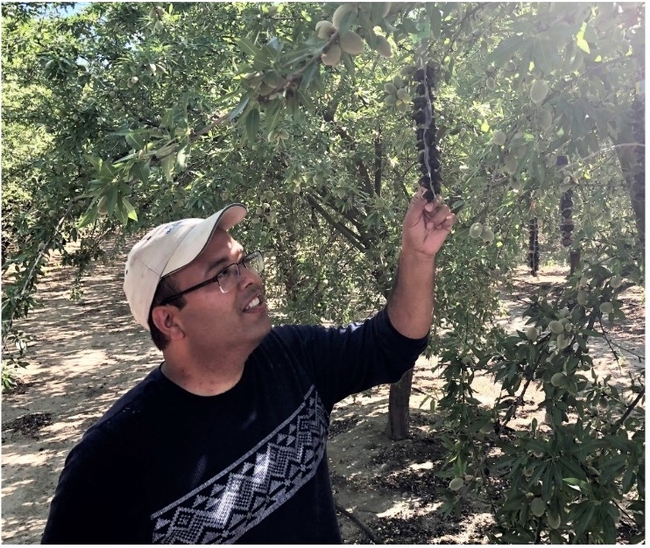
Sudan Gyawaly joined UCCE on July 5 as an area integrated pest management advisor serving Butte, Sutter, Yuba, Glenn, Colusa and Tehama counties.
Prior to becoming an IPM advisor, Gyawaly was an associate specialist at UCCE in Stanislaus County, where he studied tree nut pests, including walnut husk fly, navel orangeworm, and Pacific flatheaded borer. Before that, he was a post-doctoral researcher at North Carolina Agricultural and Technical State University in Greensboro, studying pest management on vegetables and fruit trees on small farms.
In his new role, Gyawaly is learning about the crops and pest situation in the region by talking with growers and other stakeholders. He plans to develop a need-based applied IPM research and extension program for orchards, tree nuts and other crops grown in the region.
He earned an M.S. in entomology from West Virginia University and a Ph.D. in entomology from Virginia Tech.
He earned his undergraduate degree in agriculture in his native Nepal, then worked in rural areas of Nepal for a couple of years, providing sustainable vegetable production and pest management trainings to growers before moving to the United States in 2009 for graduate studies.
Gyawaly is based in Oroville and can be reached at sgyawaly@ucanr.edu.
Martinico named human-wildlife interactions advisor 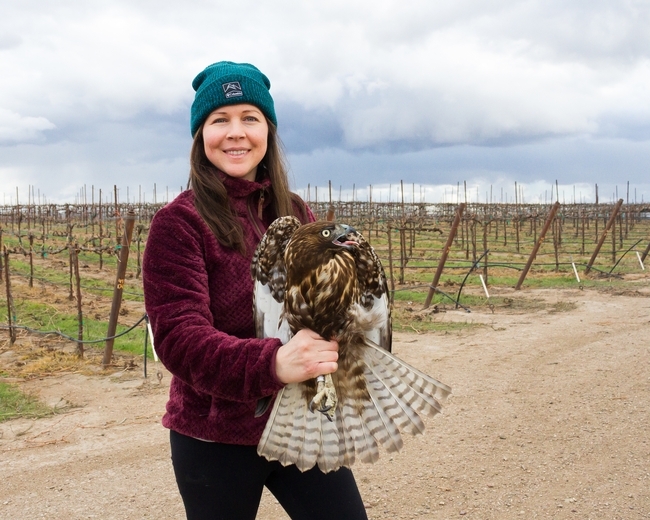
Breanna Martinico joined UC Cooperative Extension on July 5 as a human-wildlife interactions advisor for Napa, Lake and Solano counties. She will work on issues that involve wildlife as agricultural pests as well as beneficial species. To learn about priority issues for the area, she will be conducting a needs assessment.
Martinico is a wildlife biologist and ecologist, specializing in ornithology. Her past research addressed the role of birds on farms as pests and pest control agents. She has worked on projects investigating the important role farmland plays as habitat for California birds. In other work with the USDA Western Sustainable Agriculture Research and Education program, she investigated the effects of agricultural land-use and pest management practices on raptor ecology and conservation.
“I am compelled by the co-existence and mutual benefits of humans and wildlife in agroecosystems and committed to working to find solutions that benefit both people and wildlife,” Martinico said. “I am excited to be part of UC ANR where I can develop a research and extension program that has the power to increase knowledge and adoption of management practices that promote ecological sustainability and increase farm viability in California.”
She earned a B.S. in wildlife, fish and conservation biology and M.S. in avian sciences, and has nearly completed her Ph.D. in ecology, all from UC Davis.
Martinico is based in Napa and can be reached at bmartinico@ucanr.edu.
Padasas named nutrition and health advisor 
Irene Padasas started as UC Cooperative Extension community nutrition and health advisor for Tulare, Kings, Madera and Fresno counties on June 13.
Padasas will design her education and research programs for communities based on their priority needs within the broad areas of healthy lifestyles, health equity, food, nutrition, water security and safety, and climate change and health.
As part of UC Agriculture and Natural Resources' work to promote healthy families and communities, Padasas also will support the efforts of the Expanded Food and Nutrition Education Program in California and the Cal Fresh Healthy Living, University of California Nutrition Education Program.
After earning a bachelor's in special education at the University of the Philippines Diliman, and a master's in developmental psychology from the Ateneo de Manila University, Padasas received her Ph.D. in human sciences – with a specialization in global family health and well-being – from the University of Nebraska at Lincoln.
In Nebraska, Padasas played a significant role in extension programs that promote positive and healthy child and adolescent development, such as co-developing curriculum for UpStarts, a program that provides youth entrepreneurship and STEAM (Science, Technology, Engineering, Arts and Math) education for high school students in rural areas.
She also led the analyses of qualitative data from the Ecological Approach to Family Style Dining, a research intervention program that aims to support young children's health and nutrition in early childcare centers subsidized by USDA's Child and Adult Care Food Program.
Padasas' current research centers on social and cultural factors that shape the quality of life and well-being of families.
“To serve our communities more effectively as an advisor, I'm focused on exploring the role of culture in health communication to better understand adoption and acceptance of health and nutrition education programs in the community,” Padasas said.
Padasas is based at the UCCE office in Tulare and can be reached at iopadasas@ucanr.edu.
Goncalves named UCCE diversified agriculture advisor for Lake and Mendocino counties 
Clebson Goncalves joined UC Cooperative Extension on July 1 as a diversified agriculture advisor serving Lake and Mendocino counties.
Prior to moving to California, Goncalves was a postdoctoral researcher working on the management of turfgrass and ornamental crops for a USDA-SCRI project at the School of Plant and Environmental Sciences at Virginia Tech.
He has a bachelor's degree in agronomy (focused on plant pathology) and a master's degree and Ph.D. in agronomy sciences (plant production/ weed science) from Brazil, as well as an additional master's degree in crop and soil science (turfgrass/weed science) from Auburn University. He led field, greenhouse and lab research with a broad focus on plant production, crop protection and weed sciences.
Goncalves' current research centers around diversified agricultural farms, including vegetables, fruit and nut crops. He is also interested in integrated weed management practices exploring chemical and organic options, improving pesticide application technology, drone use for data collection, pesticide application and pollinator-serving plant communities.
Goncalves is based in Lakeport and can be reached at goncalves@ucanr.edu. Follow him on Twitter @clebson_g.
Shogren named UCCE environmental horticulture advisor 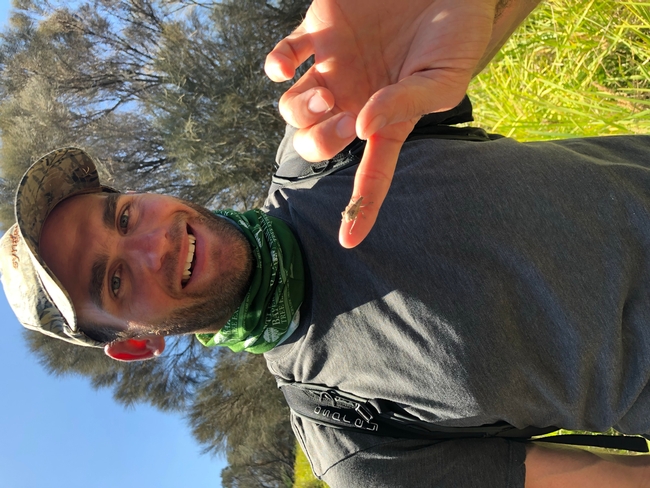
Chris Shogren joined UC ANR on June 5 as the environmental horticulture advisor for UC Cooperative Extension in Los Angeles County.
Shogren described his new role as “giving back to the community.” While he has more experience “growing plants than playing with insects,” Shogren's expertise includes all aspects of horticulture such as entomology, pathology, water use and more.
He earned a bachelor's degree in horticulture and agricultural business from Cal Poly San Luis Obispo, and a doctorate in entomology from UC Riverside.
Much of what he knows not only comes from his formal academic training, but what he learned from his parents. Shogren grew up in Hemet, 25 miles outside of Palm Springs, and spent his childhood working at his parents' wholesale nursery. Building rapport with nurseries comes naturally to Shogren and he has been advising them since his days as a Ph.D. student.
Early in his career, Shogren worked on horticulture for Disneyland before joining the Citrus Research Board, where he focused on biocontrol rearing. Prior to joining UC ANR, Shogren mass reared fruit flies for U.S. Department of Agriculture research.
As an advisor, Shogren's top priority is to develop his program by first understanding the local issues and the key players that are addressing them such as advisors, researchers and industry groups. He believes that doing so will paint a clear picture of where and how he can be the most effective.
Shogren is based out of the UC Cooperative Extension office in Los Angeles County and can be reached at cjshogren@ucanr.edu.
Singh joins UCCE Central Sierra as local food systems advisor 
Hardeep Singh joined UCCE Central Sierra as a local food systems advisor on June 1.
He transferred from the UCCE Fresno office where he worked as an assistant specialist in small farms and specialty crops. Singh, who is from Punjab, India, worked closely with Southeast Asian small farmers, African American farmers, Latino farmers and Punjabi farmers. Much of his work focused on healthy soil practices, the Irrigated Lands Regulatory Program, Coronavirus Food Assistance Program, and UC San Francisco COVID-19 Equity Project since 2020. He also worked as a vineyard operations intern with UCCE Fresno in the summer of 2019.
Singh holds a master's degree in plant science from California State University, Fresno with a distinction as Dean's Graduate Medalist. He also holds a bachelor's degree in agriculture from Punjab Agriculture University, Ludhiana, in India.
His research background includes crops such as moringa, cover crops, wine grapes, almonds, pistachios and citrus. With the exception of pistachios, Singh also has research experience in irrigation scheduling and nutrition management for these same crops.
Singh is interested in developing crop coefficients, studying nitrogen dynamics in specialty crops, and reducing production costs for small farms, which aligns with his goal of reducing poverty by engaging with socially disadvantaged communities and moving agriculture toward greater self-sustainability.
Singh is based in San Andreas and can be reached at hdsing@ucanr.edu and (559) 579-6065.
Mukherjee named urban and small farms advisor 
Amrita Mukherjee joined UC ANR on April 1 as an urban agriculture and small farms advisor serving Los Angeles, San Bernardino, Riverside and Orange counties.
Mukherjee's priority is to understand small farms' practices and needs, and to identify opportunities for improvement and/or collaboration. One challenge that Mukherjee is eager to overcome is getting information to farmers in a timely and organized manner.
“There's so much information out there and it's hard to know who is doing what,” she said. By implementing a communication system, Mukherjee believes that supporting small farms will become more efficient.
Originally from Bangladesh, Mukherjee grew up in a family of farmers and understands the struggles farmers encounter as laborers and as a business. Her upbringing inspired her to not only pursue a career in agriculture, but to alleviate the hardships that often burden farmers.
Previously, Mukherjee worked for the International Rice Research Institute where she examined flash flood risk-management in her homeland. She also worked for the Horticulture Innovation Lab management team at UC Davis as an assistant specialist in Bangladesh, focused on nutrition impacts of horticultural innovations.
Mukherjee earned a bachelor's degree in agriculture from Khulna University, a master's degree in biotechnology from Bangladesh Agricultural University, and a master's degree in horticulture, plant biology and post-harvest physiology from Kansas State University.
While she has dedicated the first few months of her role to networking, Mukherjee feels that building rapport with small-scale farmers is an ongoing process that is crucial to her role as an advisor.
When asked what she is most excited about, Mukherjee said that she wants to help farmers grow – not just their crops, but their business strategy and network. “I don't want to be a supervisor, I want to be a connector,” explained Mukherjee.
Mukherjee is based at the UC Cooperative Extension office in Highland in San Bernardino County and can be reached at amukherjee@ucanr.edu.
Sope connects journalists with UC ANR experts 
Saoimanu “Saoi” (rhymes with Maui) Sope joined UC ANR Strategic Communications on June 7 as a communications specialist to help journalists connect with UC ANR experts.
Prior to joining UC ANR, Sope worked in tobacco control policy for the state of California with a focus on effective messaging. Early in her career, she worked as a communications specialist for Driscoll's in Watsonville.
Sope earned a bachelor's degree in film and digital media and community studies from UC Santa Cruz and a Master of Public Health degree in environmental health science and certificate in toxicology from Columbia University Mailman School of Public Health.
Based at UC South Coast Research and Extension Center in Irvine, Sope can be reached at ssope@ucanr.edu. Follow her on Twitter @saoimanu.

